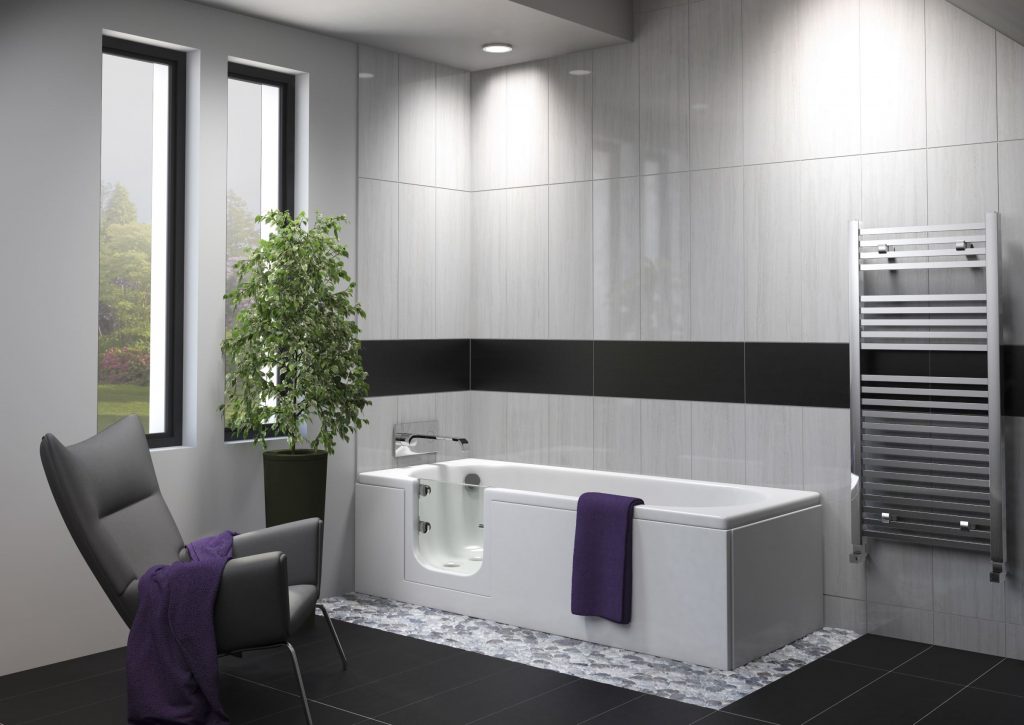Buying a walk-in bath, sometimes referred to as a bath with a door, is a decision which requires careful thought. It’s an expensive purchase and anyone thinking of buying one will want reassurance they have selected the right bath for their needs.
Before deciding on which bath to choose, it’s wise to first consider the various different options available, as well as what is involved in the installation process. In this two part blog we take a look at each of these important factors to help you decide.
Your mobility needs
Everyone considering a walk-in bath has different mobility needs. While a picture on a website or in a brochure may look like the right product, there are various details that may mean the bath is not suitable.
The best way to really be sure that a bath will serve you well is to try before you buy. Absolute Mobility have a showroom in Henley on Thames, displaying examples of full length baths, short length baths and walk in shower baths that we encourage you to get in and have a go (without getting wet!).
This will help you find out whether the door is easy to use. If a seat is needed in the bath. Whether the step height is comfortable. As well as to see various different tap styles and bathroom finishes.
When getting to our showroom is a little difficult for customers, Absolute Mobility also have a mobile showroom that can bring an example of a walk in bath to you.
We’ve already mentioned there are various types of walk in bath. But what is the difference between them and which one is likely to best suit you?
Short length walk-in baths
These are often referred to as tub style baths. These baths are best for people who are a little unsteady on their feet as they also include a moulded seat, which makes it easier to get up from a sitting position. The bather steps into the bath, closes the door, sits down and fills the bath to the desired level using taps within easy reach of the sitting position.
If preferred, a shower head can be positioned conveniently to one side turning the bath into a sit down shower. Grab rails can also be added to assist the user as required.
If the bathroom is large enough, these baths can be added to an existing family bathroom, retaining standard baths and showers for other members of the family. Due to their space saving size, they are also suitable for adding to the corner of a bedroom or annex.
Full length walk in bath
Where someone can get up and down from the sitting position in the bath, but struggles with gaining access, a full length walk-in bath may be more suitable. Essentially this is a standard bath with a door for easy access. Once safely inside the bath and the door is closed it can be filled and used exactly as you would a standard bath tub.
Whilst this may be ideal for current needs, it is a good idea to consider how things may change in the future. Whilst getting up and down may not be a problem at the moment, this may change. If it does, a bath lift can easily be added to provide extra assistance.
Full length walk in bath with lifting seat
This is, perhaps, the most desirable walk in bath. It retains the traditional full length bath design, allowing a bather to recline and enjoy a proper bath all over again. The walk-in door provides easy access and once over the low step threshold, the bather can get down and up using a powered lifting seat.
Whereas short length baths will always be more suited to people with advanced mobility needs, this style of full length walk-in bath with a lifting seat is best for people who need a bit of extra help getting up and down in the bath.
The Aventis and The Cambridge are both good examples of this type of bath and prove very popular with our customers.
Power baths
These type of baths are suited to more intensive caring needs for disabled people or people with very reduced mobility. Designed to help manoeuvre someone from their wheelchair or bed into the bath, they feature a powered seat that will safely lift the occupant over the edge of the bath and lower them gently into the water. Once the bather has finished, the seat will then help them back out of the bath.
While power baths are mostly used in care home situations we do have models that are also suitable for residential situations.
Many power baths come with a Hi-Lo function to raise and lower the bath so that carers can provide assistance. Some come with lifting seats. Others, like the Lincoln, has a bathing board to assist a person who is unable to move.
As this type of bath is large and heavy it may require floor reinforcing. In view of this, it is best to seek an installation from professionals who have extensive experience installing these types of baths.
For more details about installation of a walk in bath be sure to explore more in part 2.
If you have any further questions or would like to speak with one of team then contact us on 0800 29 22 110 or here .
3 September,2014







